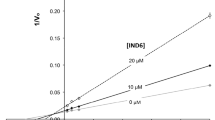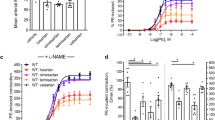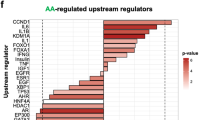Abstract
Adrenomedullin (AM), a potent vasodilator peptide, has recently been suggested to function as an endogenous antioxidant. However, its potential site of action at the cellular level has not been clarified. The present study was undertaken to investigate whether AM directly inhibits intracellular reactive oxygen species (ROS) generation and redox-sensitive gene expression stimulated by angiotensin (Ang) II in rat aortic endothelial cells (ECs). Ang II (10-7 mol/l) significantly increased intracellular ROS levels in ECs as measured by dichlorofluorescein (DCF) fluorescence. AM inhibited Ang II-stimulated ROS generation in a dose-dependent manner and this effect was abolished by a superoxide radical scavenger, NAD(P)H oxidase inhibitor, and a protein kinase A (PKA) inhibitor, and mimicked by a cell-permeable cAMP analog. A real-time reverse transcription−polymerase chain reaction (RT-PCR) study showed that Ang II significantly upregulated a set of redox-sensitive genes (ICAM-1, VCAM-1, PAI-1, tissue factor, MCP-1, osteopontin), and these effects were blocked by an antioxidant, N-acetyl cysteine (NAC). AM similarly and dose-dependently inhibited the Ang II-induced upregulation of the entire set of these genes via a receptor-mediated and PKA-dependent pathway, and the degrees of inhibition were similar to those by NAC. In conclusion, the present study demonstrated that AM potently blocked the Ang II-stimulated intracellular ROS generation from NAD(P)H oxidase and the subsequent redox-sensitive gene expression via a cAMP-dependent mechanism in ECs, suggesting that AM has vasculoprotective effects against pro-oxidant stimuli.
Similar content being viewed by others
Article PDF
References
Griendling KK, Sorescu D, Ushio-Fukai M : NAD(P)H oxidase: role in cardiovascular biology and disease. Circ Res 2000; 86: 494–501.
Alexander RW : Theodore Cooper Memorial Lecture. Hypertension and the pathogenesis of atherosclerosis. Oxidative stress and the mediation of arterial inflammatory response: a new perspective. Hypertension 1995; 25: 155–161.
Griendling KK, Minieri CA, Ollerenshaw JD, Alexander RW : Angiotensin II stimulates NADH and NADPH oxidase activity in cultured vascular smooth muscle cells. Circ Res 1994; 74: 1141–1148.
Ushio-Fukai M, Zafari AM, Fukui T, Ishizaka N, Griendling KK : p22phox is a critical component of the superoxide-generating NADH/NADPH oxidase system and regulates angiotensin II-induced hypertrophy in vascular smooth muscle cells. J Biol Chem 1996; 271: 23317–23321.
Dohi Y, Ohashi M, Sugiyama M, Takase H, Sato K, Ueda R : Candesartan reduces oxidative stress and inflammation in patients with essential hypertension. Hypertens Res 2003; 26: 691–697.
Griendling KK, Sorescu D, Lassegue B, Ushio-Fukai M : Modulation of protein kinase activity and gene expression by reactive oxygen species and their role in vascular physiology and pathophysiology. Arterioscler Thromb Vasc Biol 2000; 20: 2175–2183.
Kunsch C, Medford RM : Oxidative stress as a regulator of gene expression in the vasculature. Circ Res 1999; 85: 753–766.
Tomiyama H, Kushiro T, Okazaki R, Yoshida H, Doba N, Yamashina A : Influences of increased oxidative stress on endothelial function, platelets function, and fibrinolysis in hypertension associated with glucose intolerance. Hypertens Res 2003; 26: 295–300.
Kitamura K, Kangawa K, Kawamoto M, et al: Adrenomedullin: a novel hypotensive peptide isolated from human pheochromocytoma. Biochem Biophys Res Commun 1993; 192: 553–560.
Minamino N, Kikumoto K, Isumi Y : Regulation of adrenomedullin expression and release. Microsc Res Tech 2002; 57: 28–39.
Minamino N, Kangawa K, Matsuo H : Adrenomedullin: a new peptidergic regulator of the vascular function. Clin Hemorheol Microcirc 2000; 23: 95–102.
Shichiri M, Hirata Y : Regulation of cell growth and apoptosis by adrenomedullin. Hypertens Res 2003; 26: S9–S14.
Shimosawa T, Shibagaki Y, Ishibashi K, et al: Adrenomedullin, an endogenous peptide, counteracts cardiovascular damage. Circulation 2002; 105: 106–111.
McGuire PG, Orkin RW : Isolation of rat aortic endothelial cells by primary explant techniques and their phenotypic modulation by defined substrata. Lab Invest 1987; 57: 94–105.
Xie Z, Pimental DR, Lohan S, et al: Regulation of angiotensin II-stimulated osteopontin expression in cardiac microvascular endothelial cells: role of p42/44 mitogen-activated protein kinase and reactive oxygen species. J Cell Physiol 2001; 188: 132–138.
Shichiri M, Hirata Y : Antiangiogenesis signals by endostatin. FASEB J 2001; 15: 1044–1053.
Fridovich I : Superoxide anion radical (O2•¯), superoxide dismutases, and related matters. J Biol Chem 1997; 272: 18515–18517.
Kato K, Yin H, Agata J, Yoshida H, Chao L, Chao J : Adrenomedullin gene delivery attenuates myocardial infarction and apoptosis after ischemia and reperfusion. Am J Physiol 2003; 285: H1506–H1514.
Shimosawa T, Matsui H, Xing G, Itakura K, Ando K, Fujita T : Organ-protective effects of adrenomedullin. Hypertens Res 2003; 26 ( Suppl): S109–S112.
Ando K, Ito Y, Kumada M, Fujita T : Oxidative stress increases adrenomedullin mRNA levels in cultured rat vascular smooth muscle cells. Hypertens Res 1998; 21: 187–191.
Yoshimoto T, Fukai N, Sato R, et al: Antioxidant effect of adrenomedullin on angiotensin II-induced reactive oxygen species generation in vascular smooth muscle cells. Endocrinology 2004; 145: 3331–3337.
Meyer M, Schreck R, Baeuerle PA : H2O2 and antioxidants have opposite effects on activation of NF-kappa B and AP-1 in intact cells: AP-1 as secondary antioxidant-responsive factor. EMBO J 1993; 12: 2005–2015.
Gomez del Arco P, Martinez-Martinez S, Calvo V, Armesilla AL, Redondo JM : Antioxidants and AP-1 activation: a brief overview. Immunobiology 1997; 198: 273–278.
Kato H, Shichiri M, Marumo F, Hirata Y : Adrenomedullin as an autocrine/paracrine apoptosis survival factor for rat endothelial cells. Endocrinology 1997; 138: 2615–2620.
Miyashita K, Itoh H, Sawada N, et al: Adrenomedullin promotes proliferation and migration of cultured endothelial cells. Hypertens Res 2003; 26 ( Suppl): S93–S98.
Nishimatsu H, Hirata Y, Shindo T, et al: Endothelial responses of the aorta from adrenomedullin transgenic mice and knockout mice. Hypertens Res 2003; 26 ( Suppl): S79–S84.
Michibata H, Mukoyama M, Tanaka I, et al: Autocrine/paracrine role of adrenomedullin in cultured endothelial and mesangial cells. Kidney Int 1998; 53: 979–985.
Author information
Authors and Affiliations
Corresponding author
Rights and permissions
About this article
Cite this article
Yoshimoto, T., Gochou, N., Fukai, N. et al. Adrenomedullin Inhibits Angiotensin II-Induced Oxidative Stress and Gene Expression in Rat Endothelial Cells. Hypertens Res 28, 165–172 (2005). https://doi.org/10.1291/hypres.28.165
Received:
Accepted:
Issue date:
DOI: https://doi.org/10.1291/hypres.28.165
Keywords
This article is cited by
-
Dysregulation of Cerebellar Adrenomedullin Signaling During Hypertension
Journal of Molecular Neuroscience (2017)
-
Effect of Valsartan on Cerebellar Adrenomedullin System Dysregulation During Hypertension
The Cerebellum (2017)
-
Genomic analysis of Ugandan and Rwandan chicken ecotypes using a 600 k genotyping array
BMC Genomics (2016)
-
Anti-angiogenic activity of macrolactin A and its succinyl derivative is mediated through inhibition of class I PI3K activity and its signaling
Archives of Pharmacal Research (2015)
-
Bone Marrow Stromal Cells Inhibit the Activation of Liver Cirrhotic Fat-Storing Cells via Adrenomedullin Secretion
Digestive Diseases and Sciences (2015)



